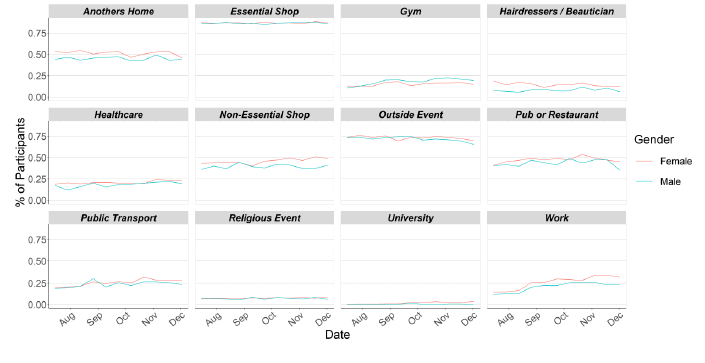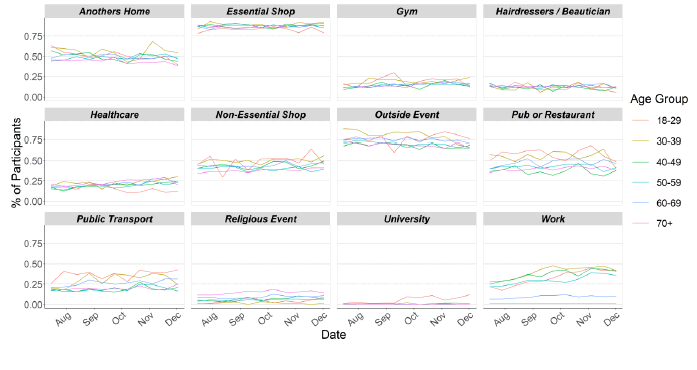Coronavirus (COVID-19): modelling the epidemic (issue no.82)
Latest findings in modelling the COVID-19 epidemic in Scotland, both in terms of the spread of the disease through the population (epidemiological modelling) and of the demands it will place on the system, for example in terms of health care requirement.
This document is part of a collection
Technical Annex
Epidemiology is the study of how diseases spread within populations. One way we do this is using our best understanding of the way the infection is passed on and how it affects people who catch it to create mathematical simulations. Because people who catch Covid-19 have a relatively long period in which they can pass it on to others before they begin to have symptoms, and the majority of people infected with the virus will experience mild symptoms, this "epidemiological modelling" provides insights into the epidemic that cannot easily be measured through testing e.g. of those with symptoms, as it estimates the total number of new daily infections and infectious people, including those who are asymptomatic or have mild symptoms.
Modelling also allows us to make short-term forecasts of what may happen with a degree of uncertainty. These can be used in health care and other planning. The modelling in this research findings is undertaken using different types of data which going forward aims to both model the progress of the epidemic in Scotland and provide early indications of where any changes are taking place.
The delivery of the vaccination programme will offer protection against severe disease and death. The modelling includes assumptions about compliance with restrictions and vaccine take-up. Work is still ongoing to understand how many vaccinated people might still spread the virus if infected. As Covid-19 is a new disease there remain uncertainties associated with vaccine effectiveness. Furthermore, there is a risk that new variants emerge for which immunisation is less effective.
How the modelling compares to the real data as it emerges
The method of producing the medium term projections (Figures 9 - 11) uses the published actual numbers of infections, rather than modelling them from the beginning of the epidemic. This means the projections begin from the point the published data ends.
There is no prediction interval around the actual infections in Figure 5 - 7 because there is no longer any uncertainty from simulating infections during this period. There is still uncertainty in the ascertainment rate, which is represented by the whiskers around the actual infections.
How do the locations visited by individuals vary between age and gender?
Figures 20 & 21 illustrate the proportion of individuals attending different locations by gender and age for Panel B.
Differences between the number of females and males visiting different locations are small where they occur. These show a higher proportion of females visiting another's home, a hairdresser/beautician, non-essential shop and work than males and a slightly higher proportion of males visiting the gym compared to females. The remaining locations are similar in proportions.

In terms of age, the biggest difference is seen in attendance to a work setting. At most, 12% of participants 60 and over attend the workplace while a minimum of 17%, rising up to 48%, of the 18-59s attend the workplace during the same period.

How is the doubling time for the Omicron variant calculated?
In a recent WHO report[12] it was confirmed that in PCR tests one of the three target genes of the SARS-CoV-2 virus is not detected (called S‑gene target failure, SGTF). This test can therefore be used as an indicator for the Omicron variant.
The number of total S-gene tests and the proportion which test positive for SGTF in Scotland are provided daily by PHS. Based on a methodology developed by academics at the University of Manchester, a statistical model is based on some underlying parameters of the Omicron variant. This is fitted against the actual number of S-gene test and the proportion of these which are positive for SGTF using maximum likelihood. This allows for a best estimate of the underlying parameters, including the relative growth advantage of the Omicron variant, which leads to an estimate of the doubling time of the variant.
The axis on the graph in Figure 8 is a proportion i.e. 0 = 0%, 1 = 100%. Therefore, the graph is showing an estimated proportion of Omicron cases, starting at 0% of cases in early November. The proportion is calculated as S-gene target failure cases as a proportion of all cases tested for the S-gene.
To reflect the uncertainty the modelling has a random sampling element to the methodology. The red band represents the variance between these samples.
We have more information on Omicron but need more to confirm its characteristics, particularly around severity. As this becomes available we will refine the modelling.
Which local authorities are likely to experience high levels of Covid-19 in two weeks' time
This is based on the Delta variant being the majority of cases.
| Probability of exceeding (cases per 100K) |
||||
|---|---|---|---|---|
| Local Authority (LA) |
50 |
100 |
300 |
500 |
| Aberdeen City |
75-100% |
75-100% |
50-75% |
15-25% |
| Aberdeenshire |
75-100% |
75-100% |
25-50% |
15-25% |
| Angus |
75-100% |
75-100% |
25-50% |
0-5% |
| Argyll and Bute |
75-100% |
75-100% |
25-50% |
5-15% |
| City of Edinburgh |
75-100% |
75-100% |
75-100% |
25-50% |
| Clackmannanshire |
75-100% |
75-100% |
50-75% |
15-25% |
| Dumfries & Galloway |
75-100% |
75-100% |
50-75% |
5-15% |
| Dundee City |
75-100% |
75-100% |
50-75% |
15-25% |
| East Ayrshire |
75-100% |
75-100% |
75-100% |
75-100% |
| East Dunbartonshire |
75-100% |
75-100% |
75-100% |
50-75% |
| East Lothian |
75-100% |
75-100% |
50-75% |
25-50% |
| East Renfrewshire |
75-100% |
75-100% |
50-75% |
50-75% |
| Falkirk |
75-100% |
75-100% |
75-100% |
50-75% |
| Fife |
75-100% |
75-100% |
50-75% |
15-25% |
| Glasgow City |
75-100% |
75-100% |
75-100% |
50-75% |
| Highland |
75-100% |
75-100% |
25-50% |
15-25% |
| Inverclyde |
75-100% |
75-100% |
50-75% |
25-50% |
| Midlothian |
75-100% |
75-100% |
50-75% |
25-50% |
| Moray |
75-100% |
75-100% |
50-75% |
25-50% |
| Na h-Eileanan Siar |
50-75% |
50-75% |
25-50% |
5-15% |
| North Ayrshire |
75-100% |
75-100% |
75-100% |
25-50% |
| North Lanarkshire |
75-100% |
75-100% |
75-100% |
50-75% |
| Orkney Islands |
50-75% |
15-25% |
0-5% |
0-5% |
| Perth and Kinross |
75-100% |
75-100% |
50-75% |
15-25% |
| Renfrewshire |
75-100% |
75-100% |
75-100% |
50-75% |
| Scottish Borders |
75-100% |
75-100% |
25-50% |
5-15% |
| Shetland Islands |
25-50% |
25-50% |
15-25% |
5-15% |
| South Ayrshire |
75-100% |
75-100% |
75-100% |
25-50% |
| South Lanarkshire |
75-100% |
75-100% |
75-100% |
50-75% |
| Stirling |
75-100% |
75-100% |
50-75% |
25-50% |
| West Dunbartonshire |
75-100% |
75-100% |
75-100% |
25-50% |
| West Lothian |
75-100% |
75-100% |
75-100% |
50-75% |
What levels of Covid-19 are indicated by wastewater data?
Table 2 provides population weighted daily averages for normalised WW Covid-19 levels in the weeks beginning 1st and 8th December 2021, with no estimate for error. This is given in Million gene copies per person, which approximately corresponds to new cases per 100,000 per day. Coverage is given as percentage of LA inhabitants covered by a wastewater Covid‑19 sampling site delivering data during this period[13].
| Local authority (LA) |
w/b 1st December |
w/b 8th December |
Coverage |
|---|---|---|---|
| Aberdeen City |
49 |
37 |
99% |
| Aberdeenshire |
37 |
32 |
34% |
| Angus |
64 |
39 |
55% |
| Argyll and Bute |
44 |
18 |
12% |
| City of Edinburgh |
56 |
54 |
98% |
| Clackmannanshire |
49 |
74 |
81% |
| Dumfries & Galloway |
16 |
41 |
35% |
| Dundee City |
78 |
39 |
100% |
| East Ayrshire |
91 |
42 |
57% |
| East Dunbartonshire |
102 |
117 |
99% |
| East Lothian |
63 |
50 |
74% |
| East Renfrewshire |
42 |
62 |
89% |
| Falkirk |
120 |
84 |
79% |
| Fife |
114 |
52 |
84% |
| Glasgow City |
72 |
89 |
71% |
| Highland |
68 |
13 |
36% |
| Inverclyde |
62 |
51 |
98% |
| Midlothian |
55 |
55 |
73% |
| Moray |
52 |
27 |
28% |
| Na h-Eileanan Siar |
– |
– |
0% |
| North Ayrshire |
81 |
37 |
84% |
| North Lanarkshire |
105 |
92 |
30% |
| Orkney Islands |
18 |
8 |
34% |
| Perth and Kinross |
77 |
24 |
38% |
| Renfrewshire |
59 |
69 |
97% |
| Scottish Borders |
42 |
27 |
58% |
| Shetland Islands |
– |
– |
0% |
| South Ayrshire |
94 |
45 |
84% |
| South Lanarkshire |
60 |
82 |
57% |
| Stirling |
33 |
10 |
53% |
| West Dunbartonshire |
80 |
62 |
98% |
| West Lothian |
128 |
41 |
76% |
Contact
There is a problem
Thanks for your feedback